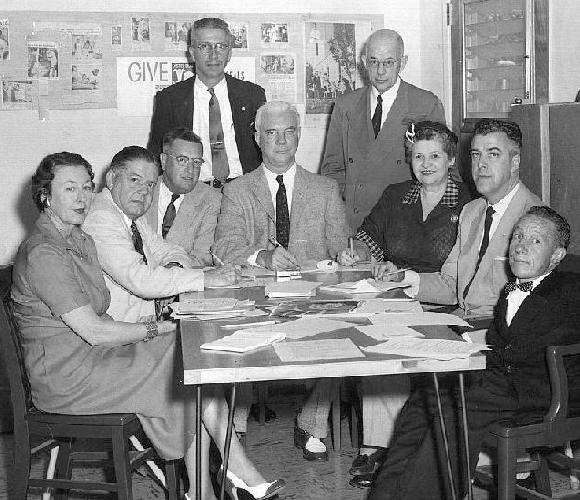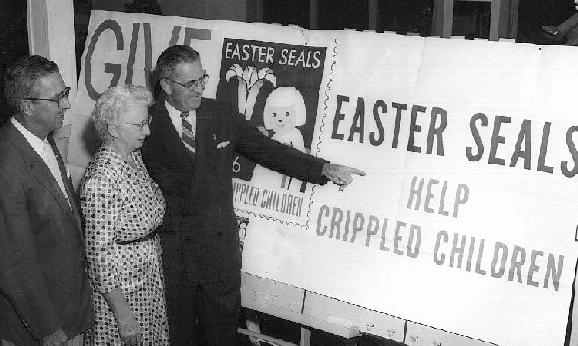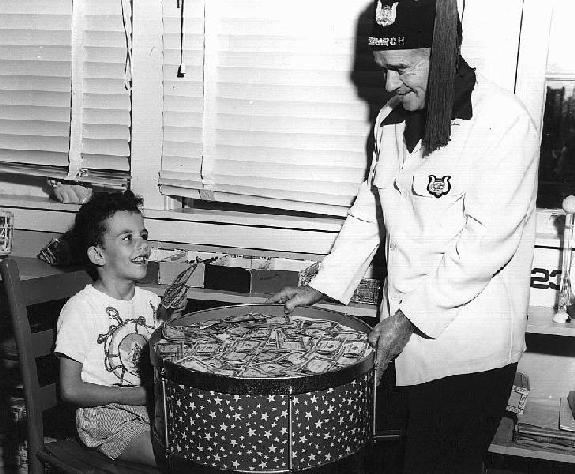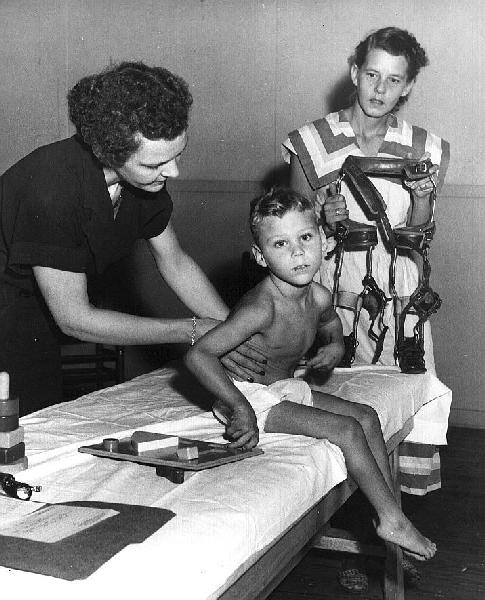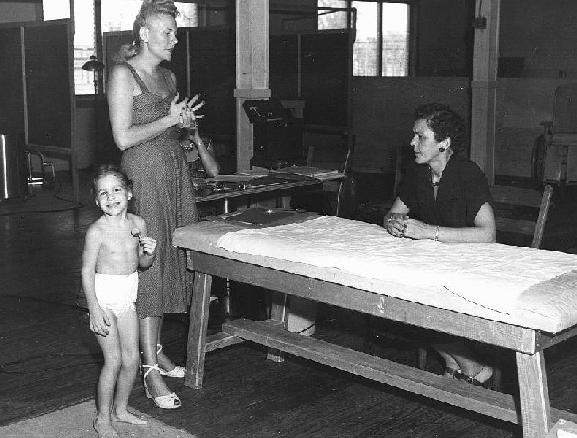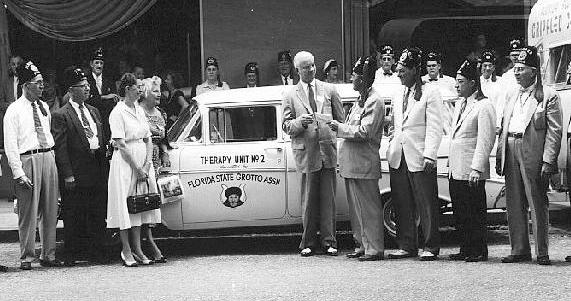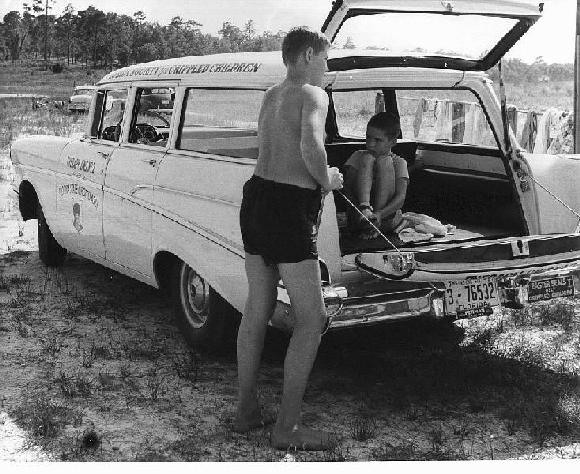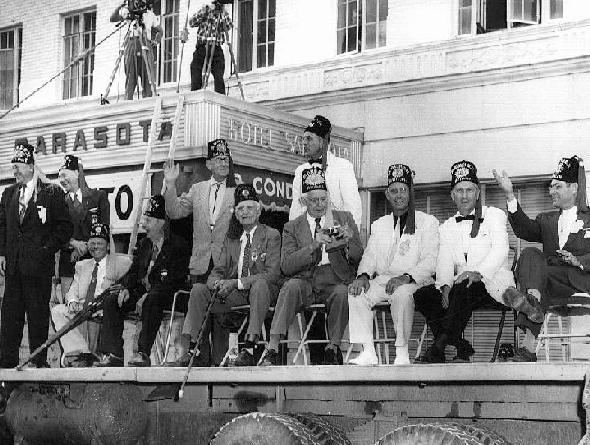The Beginning of Easter Seals
in Florida
In 1954 a group of community leaders who were connected to each other through the Masonic Order and Eastern Star of Florida met in Orlando to plan the kick-off campaign for a new National Program called Easter Seals. (Left to right: Mrs. David L. Black - Daytona Beach; J. W. Dupree - Tampa; Francis C. Walton - Daytona Beach; Earl E. Lettelier, Sr. - Ft. Lauderdale; A. Pickens Coles, President - Tampa; Robert S. Carr - Orlando; Mr. R. B. Sensabaugh - Gainesville; Lisle Reese, Executive Director - Orlando; Judge A. J. Hayward, Jr. - Dade City)
Their mission was to help, aide and assist the National Easter Seals Foundation by raising money locally and funding an Easter Seals Clinic and Mobile Therapy Units to travel statewide helping crippled and disabled children. (Left to right: Earl E. Lettelier, Sr., Mrs. Netta Kessler, and Frank Ghiotto)
A poster child was selected and Florida Grotto Units lead by Feramo Grotto in Ft. Lauderdale quickly raised needed monies.
The first Easter Seals Clinic was opened in Ft. Lauderdale, Florida at the old Naval Air Station. Note the wheelchair ramps leading into the building!
At the clinic parents would bring their children for a variety of free clinical services.
Many of the children didn't even have a clue of the seriousness of their conditions (flat footed and feet turned out). The look on the mothers face above is one of worry, yet her little girl smiles happily for the photographers camera.
The Florida State Grotto Association is seen here presenting a check to the Easter Seals Foundation President A. Pickens Coles as well as two mobile therapy units.
Many of Florida's disabled children lived in rural areas far from the Ft. Lauderdale clinic. These 1957 Chevy Station Wagons were staffed by a driver and a nurse who took their work into the field to visit them.
Many parades were held around Florida by the Florida State Grotto Assoc. to popularize the Easter Seals Campaign. Note the early television movie cameras on the top of the entrance to the old Sarasota Hotel.
A special "Thanks" to our Museum Curator David J. Lettelier, who's grandfather Earl E. Lettelier, Sr. was the Fla. State Grotto President and responsible for having the above photos taken. His grandfather rallied behind the Easter Seals campaign when his youngest son Jack Lettelier (David's uncle) was born with cerebral palsy. To become active in an Easter Seals Chapter near you click on the links below:
The Easter Seals Story
Easter Seals has been helping individuals with disabilities and special needs, and their families, live better lives for more than 80 years. Whether helping someone improve physical mobility, return to work or simply gain greater independence for everyday living, Easter Seals offers a variety of services to help people with disabilities address life's challenges and achieve personal goals.
Tragedy Leads to Inspiration
In 1907, Ohio-businessman Edgar Allen lost his son in a streetcar accident. The lack of adequate medical services available to save his son prompted Allen to sell his business and begin a fund-raising campaign to build a hospital in his hometown of Elyria, Ohio. Through this new hospital, Allen was surprised to learn that children with disabilities were often hidden from public view. Inspired by this discovery, in 1919 Allen founded what became known as the National Society for Crippled Children, the first organization of its kind.The Birth of the Seal
In the spring of 1934, the organization launched its first Easter "seals" campaign to raise money for its services. To show their support, donors placed the seals on envelopes and letters. Cleveland Plain Dealer cartoonist J.H. Donahey designed the first seal. Donahey based the design on a concept of simplicity because those served by the charity asked "simply for the right to live a normal life."The lily – a symbol of spring – was officially incorporated as Easter Seals' logo in 1952 for its association with resurrection and new life and has appeared on each seal since.
Easter Seals Emerges
The overwhelming public support for the Easter "seals" campaign triggered a nationwide expansion of the organization and a swell of grassroots efforts on behalf of people with disabilities. By 1967, the Easter "seal" was so well recognized, the organization formally adopted the name "Easter Seals."Easter Seals Today
Easter Seals assists more than 1 million children and adults with disabilities and their families annually through a nationwide network of more than 400 service sites. Each center provides top-quality, family-focused and innovative services tailored to meet the specific needs of the particular community it serves.Primary Easter Seals services include:
Medical Rehabilitation
- Early Intervention
- Physical Therapy
- Occupational Therapy
- Speech and Hearing TherapyJob Training & Employment
Inclusive Child Care
Adult Day Services
Camping & Recreation
Easter Seals also advocates for the passage of legislation to help people with disabilities achieve independence, including the Americans with Disabilities Act (ADA). Passed in 1990, the ADA prohibits discrimination against anyone who has a mental or physical disability, guaranteeing the civil rights of people with disabilities.
At the core of the Easter Seals organization is a common passion for caring, shared by its 13,000 staff members and thousands of volunteers, and by those who support its mission. This heart-felt commitment to helping people with disabilities and their families is what Easter Seals is all about.
Chronology
1919: Founded by Edgar Allen to help children with disabilities1934: Conducted first Easter "seal" fund-raising campaign
1944: Broadened mission to help adults
1944: Broadened mission to help adults
1950: Achieved nationwide reach
1952: Officially incorporated lily into Easter Seals symbol
1967: Adopted the name Easter Seals
1984: Served more than 1 million people annually
1990: Helped pass Americans with Disabilities Act into law
2000: Received top recognition by National Health Council for 20th consecutive year
![]()

